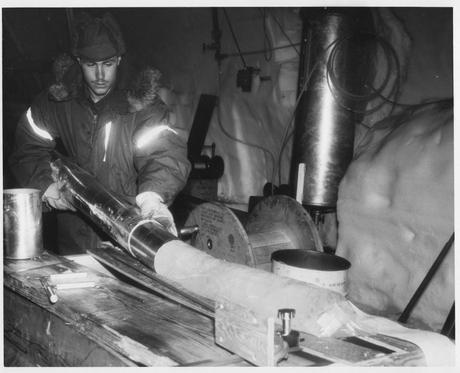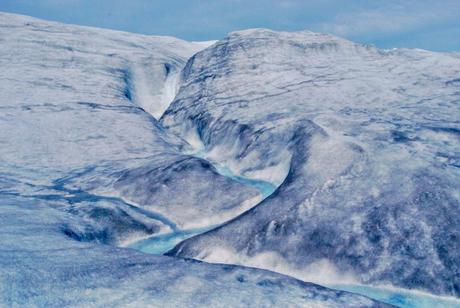About 400,000 years ago, large parts of Greenland were ice-free. The rugged tundra basked in the sun’s rays on the island’s northwestern highlands. There is evidence that a forest of spruce trees, buzzing with insects, covered the southern part of Greenland. Global sea level was then much higher, between 6 and 12 meters above current levels. Across the world, the land that today is home to hundreds of millions of people was underwater.
Scientists have known for some time that the Greenland ice sheet largely disappeared sometime in the last million years, but not exactly when.
In a new study in the journal Science, we determined the date using frozen soil mined during the Cold War from beneath a nearly mile-thick section of the Greenland ice sheet.
<iframe loading="lazy" title="Greenland's ice is vulnerable: a mile of ice vanished from northwest Greenland 400,000 years ago" width="900" height="506" src="https://www.youtube.com/embed/CYfSphNHOm8?feature=oembed" frameborder="0" allow="accelerometer; autoplay; clipboard-write; encrypted-media; gyroscope; picture-in-picture; web-share" allowfullscreen="allowfullscreen"></iframe>
The timing – about 416,000 years ago, with largely ice-free conditions lasting as long as 14,000 years – is important. At the time, Earth and its early humans were experiencing one of the longest interglacial periods since ice sheets first covered the high latitudes 2.5 million years ago.
The length, magnitude and effects of that natural warming can help us understand the Earth that modern humans are creating now for the future.
A world preserved under the ice
In July 1966, U.S. Army scientists and engineers completed a six-year effort to drill through the Greenland ice sheet. The drilling took place at Camp Century, one of the most unusual military bases. The base was nuclear powered and consisted of a series of tunnels dug into the Greenland ice sheet.
The drilling site in northwest Greenland was 220 kilometers offshore and under 1,400 meters of ice. When they reached the bottom of the ice, the team continued to drill another 12 feet into the frozen, rocky ground below.

George Linkletter, who works for the U.S. Army Corps of Engineers’ Cold Regions Research and Engineering Laboratory, examines a piece of ice core in Camp Century’s science trench. The base was closed in 1967. US Army photo
In 1969, geophysicist Willi Dansgaard’s analysis of Camp Century’s ice core revealed for the first time the details of how Earth’s climate had changed dramatically over the past 125,000 years. Longer cold ice ages during which the ice expanded rapidly gave way to warm interglacial periods when the ice melted and sea levels rose, flooding coastal areas around the world.
For nearly three decades, scientists paid little attention to Camp Century’s 11 feet of frozen ground. One study analyzed the pebbles to understand the bedrock beneath the ice sheet. Another intriguingly suggested that the frozen ground contained traces of a warmer time than today. But because the material could not be dated, few people paid attention to these studies. In the 1990s the frozen soil core had disappeared.
Several years ago, our Danish colleagues found the lost soil buried deep in a freezer in Copenhagen, and we formed an international team to analyze this unique frozen climate archive.
In the top sample we found perfectly preserved fossil plants – proof positive that the land far below Camp Century had once been ice-free – but when?
Dating ancient rocks, twigs and dirt
Using samples cut from the center of the sediment core and prepared and analyzed in the dark so that the material retains an accurate memory of its last exposure to sunlight, we now know that the ice sheet covering northwest Greenland – today almost a mile thick – has disappeared. during the extended natural warm period known to climate scientists as MIS 11, between 424,000 and 374,000 years ago.
<iframe loading="lazy" title="Optically Stimulated Luminescence - Archaeological Dating Methods" width="900" height="506" src="https://www.youtube.com/embed/TpZVa7O863A?feature=oembed" frameborder="0" allow="accelerometer; autoplay; clipboard-write; encrypted-media; gyroscope; picture-in-picture; web-share" allowfullscreen="allowfullscreen"></iframe>
Paul Bierman’s lab at the University of Vermont dated the last time the sample was close to the surface using a different method, using rare radioactive isotopes of aluminum and beryllium.
These isotopes are created when cosmic rays, originating far from our solar system, collide with rocks on Earth. Each isotope has a different half-life, meaning it decays at a different rate when buried.
By measuring both isotopes in the same sample, glacial geologist Drew Christ was able to determine that melting ice had exposed land surface sediment for less than 14,000 years.
Ice sheet models by Benjamin Keisling, which now incorporate our new knowledge that Camp Century was ice-free 416,000 years ago, show that Greenland’s ice sheet must have shrunk considerably at that time.
The edge of the ice retreated at least tens to hundreds of kilometers around much of the island during that period. The water from that melting ice raised global sea levels at least five feet and perhaps as much as six feet compared to today.
Warnings for the future
The centuries-old frozen ground beneath the Greenland ice sheet warns of future problems.
During the MIS 11 interglacial, the Earth was warm and ice sheets were limited to the high latitudes, just like today. Carbon dioxide levels in the atmosphere remained between 265 and 280 parts per million for about 30,000 years. MIS 11 lasted longer than most interglacials because of the impact of the shape of Earth’s orbit around the Sun on the solar radiation reaching the Arctic. Over these 30 millennia, that level of carbon dioxide caused enough warming to melt much of Greenland’s ice.
Today, our atmosphere contains one and a half times more carbon dioxide than it did during MIS 11, about 420 parts per million, a concentration that is rising every year. Carbon dioxide traps heat and warms the planet. Too much of it in the atmosphere raises the Earth’s temperature, as the world is now seeing.
Over the past decade, as greenhouse gas emissions continued to rise, humans experienced the eight hottest years on record. Based on preliminary data, July 2023 was the warmest week on record. Such heat melts the ice caps, and the loss of ice causes the planet to warm even further, while dark rocks suck in the sunlight that once reflected off the bright white ice and snow.


At midnight in July, meltwater flows in a winding channel over the Greenland ice sheet. Paul Bierman
Even if everyone stopped burning fossil fuels tomorrow, carbon dioxide levels in the atmosphere would remain high for thousands to tens of thousands of years. That’s because it takes a long time for carbon dioxide to reach soil, plants, the ocean and rocks. We create conditions conducive to a very long period of warmth, just like MIS 11.
Unless humans dramatically reduce the concentration of carbon dioxide in the atmosphere, the evidence we’ve found about Greenland’s past points to a largely ice-free future for the island.
Anything we can do to reduce CO2 emissions and sequester the carbon already in the atmosphere will increase the chance that more Greenland ice will survive.
The alternative is a world that could look a lot like MIS 11 – or even more extreme: a warm Earth, shrinking ice caps, rising sea levels and waves rolling over Miami, Mumbai, India and Venice, Italy.
This article is republished from The Conversation, an independent nonprofit organization providing facts and trusted analysis to help you understand our complex world. If you found it interesting, please subscribe to our weekly newsletter.
It was written by: Paul Bierman, University of Vermont and Tammy Rittenour, Utah State University.
Read more:
Paul Bierman receives funding from the US National Science Foundation.
Tammy Rittenour receives funding from the US National Science Foundation.
